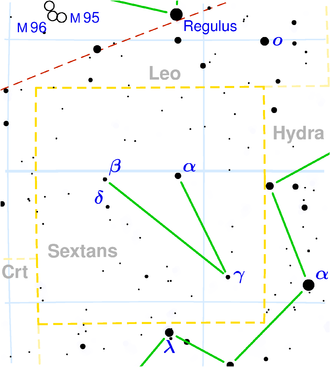NGC 3365
| Galaxy NGC 3365 |
|
|---|---|

|
|
| SDSS recording | |
| AladinLite | |
| Constellation | sextant |
|
Position equinox : J2000.0 , epoch : J2000.0 |
|
| Right ascension | 10 h 46 m 12.6 s |
| declination | + 01 ° 48 ′ 48 ″ |
| Appearance | |
| Morphological type | Sd (f) |
| Brightness (visual) | 12.5 mag |
| Brightness (B-band) | 13.2 mag |
| Angular expansion | 4.5 ′ × 0.8 ′ |
| Position angle | 159 ° |
| Surface brightness | 13.7 mag / arcmin² |
| Physical data | |
| Redshift | 0.003289 ± 0.000005 |
| Radial velocity | (986 ± 1) km / s |
|
Stroke distance v rad / H 0 |
(38 ± 3) x 10 6 ly (11.7 ± 0.8) Mpc |
| history | |
| discovery | John Herschel |
| Discovery date | April 13, 1828 |
| Catalog names | |
| NGC 3365 • UGC 5878 • PGC 32153 • CGCG 010-008 • MCG + 00-28-006 • 2MASX J10461264 + 0148479 • LDCE 0753 NED003 | |
NGC 3365 is a spiral galaxy of Hubble type SD in the constellation Sextant. It is estimated to be 38 million light years from the Milky Way .
The object was discovered by John Herschel on April 13, 1828 .
